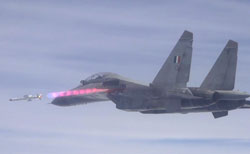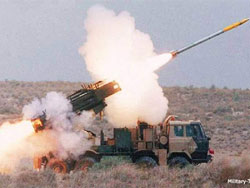INDIAN ARMED FORCES CHIEFS ON OUR RELENTLESS AND FOCUSED PUBLISHING EFFORTS

The insightful articles, inspiring narrations and analytical perspectives presented by the Editorial Team, establish an alluring connect with the reader. My compliments and best wishes to SP Guide Publications.

"Over the past 60 years, the growth of SP Guide Publications has mirrored the rising stature of Indian Navy. Its well-researched and informative magazines on Defence and Aerospace sector have served to shape an educated opinion of our military personnel, policy makers and the public alike. I wish SP's Publication team continued success, fair winds and following seas in all future endeavour!"

Since, its inception in 1964, SP Guide Publications has consistently demonstrated commitment to high-quality journalism in the aerospace and defence sectors, earning a well-deserved reputation as Asia's largest media house in this domain. I wish SP Guide Publications continued success in its pursuit of excellence.
- Prime Minister Modi Visits Punjab’s Adampur Air Base, Interacts with Airmen after Successful ‘Operation Sindoor’; Stern Message to Pakistan
- The layered Air Defence systems that worked superbly, the key element of Operation Sindoor
- Operation Sindoor | Day 2 DGMOs Briefing
- Operation Sindoor: India strikes back with Precision and Purpose
- Operation Sindoor: Resolute yet Restrained
- India’s Operation Sindoor Sends a Clear Message to Terror and the World – ‘ZERO TOLERANCE’
- Japan and India set forth a defence cooperation consultancy framework, talks on tank and jet engines
- Terrorist Attack in Pahalgam in Kashmir: Unfolding a long surgical war against PAK
- Lt General Pratik Sharma takes over Command of Indian Army's Northern Command
Amidst border face-off with China, India moves to buy 21 MiG-29 & 12 Su-30MKI fighters for $2.4 B
DAC approves military procurements worth $5.2 B, nod for 1,000 km cruise missile and Astra BVR marks major milestone in indigenous missile capability

Amidst heightened military tensions with China, India’s highest Defence procurement body on July 2 approved long-standing proposals for the purchase of 21 refurbished Russian MiG-29s and an additional 12 Sukhoi-30MKI frontline fighters.
This comes close on the heels of the visit of Defence Minister Rajnath Singh to Russia, and sets the stage for speedy contract negotiations for the acquisition of these Russian-origin fighter aircraft.
The import of 21 mothballed MiG-29s - after due restoration - and a second upgrade package for 59 fighters of this type currently in the inventory of the Indian Air Force (IAF) of will cost India $ 992 Million (7,418 Crore).
The import of 21 mothballed MiG-29s - after due restoration - and a second upgrade package for 59 fighters of this type currently in the inventory of the Indian Air Force (IAF) of will cost India $ 992 Million (7,418 Crore)
The estimated cost of 12 additional Russian origin Sukhoi-30MKIs, to be licence manufactured at HAL, will be $1.4 Billion (10,730 Crore). This is to address the “long felt need of the Indian Air Force to increase its fighter squadrons”, Ministry of Defence spokesperson A Bharat Bhushan Babu declared in a statement.
The Defence Acquisition Council (DAC) chaired by Defence Minister Rajnath Singh also gave the go-ahead for the acquisition of the indigenous 1,000-km range land attack cruise missile Nirbhay and the Beyond Visual Range (BVR) air-to-air missile Astra among $5.2 Billion (38,900 Crore) military procurement approvals announced on July 2.
The estimated cost of 12 additional Russian origin Sukhoi-30MKIs, to be licence manufactured at HAL, will be $1.4 Billion (10,730 Crore). This is to address the “long felt need of the Indian Air Force to increase its fighter squadrons”
The announcements on both the Nirbhay long-range land attack cruise missile and the Astra BVR mark major milestones in indigenous missile development and India’s goal for self-reliance in military firepower.

Government sources termed the vertical launch cruise missile a “higher version of the Nirbhay”, with a “fully indigenous” seeker, demonstrating of maturity of critical cruise missile technologies.
“The addition of Long Range Land Attack Missile Systems having a firing range of 1000 Km to the existing arsenal will bolster the attack capabilities of the Navy and the Air Force. Similarly, induction of Astra Missiles having Beyond Visual Range capability will serve as a force multiplier and immensely add to the strike capability of Navy and Air Force,” the MoD spokesperson declared.
Government sources termed the vertical launch cruise missile a “higher version of the Nirbhay”, with a “fully indigenous” seeker, demonstrating of maturity of critical cruise missile technologies
The statement emphasised the commitment to Prime Minister Narendra Modi’s call for building an atmanirbhar Bharat (self-reliant India).
“Focused on indigenous design and development, these approvalsinclude acquisitions from Indian Industry of 31130 Cr (4.2B),” the MoD statement elaborated on the DAC decisions.
“The equipments are to be manufactured in India involving Indian Defence Industry with participation of several MSMEs as prime tier vendors. The Indigenous content in some of these projects is up to 80 per cent of the project cost,” the statement added.
“Focused on indigenous design and development, these approvals include acquisitions from Indian Industry of 31130 Cr (4.2B)…The Indigenous content in some of these projects is up to 80 per cent of the project cost,” the MoD statement elaborated
“A large number of these projects have been made possible due to Transfer of Technology by DRDO to the Indigenous Industry. These include Pinaka ammunitions, BMP armament upgrades and Software Defined Radios for the Army, Long Range Land Attack Cruise Missile Systems and Astra Missiles for Navy and Air Force. The cost of these Design and Development proposals is in the range of 20400 cr ($2.7 B),” Mr Babu stated on behalf of the Ministry of Defence.
While referring to India’s firepower augmentation, the Ministry of Defence stated that the “acquisition of Pinaka missile systems will enable raising additional regiments over and above the ones already inducted”. The Pinaka, now redesignated as a missile system, will add depth and accuracy to the Indian Army’s artillery firepower.
DRDO Goes state-of-the-art
The July 2 approval by the apex military acquisition body for induction of of key indigenous systems signals the arrival of the DRDO and the maturity of several of its critical technologies
Long Range Land Attack Cruise Missile (LRLACM)

Lead in projects have developed, demonstrated and matured critical cruise missile technologies such as aerodynamic configuration, vertical launch using solid booster, thrust vector control system, booster separation, in-flight wing deployment, in-flight engine start and long range way-point navigation system. Seeker development and testing by DRDO laboratories has been successfully demonstrated by DRDO labs. A fully indigenous long range land attack cruise missile will greatly enhance the operational capability of India’s armed forces.
ASTRA

This Beyond Visual Range (BVR) class of Air-to-Air Missile (AAM) system is designed to engage and destroy highly manoeuvring supersonic aircraft. The missile has all-weather, day and night capability. It is being developed in multiple variants to meet specific requirements. The ASTRA Mk-I Weapon System integrated with SU-30 Mk-I aircraft is being inducted into the Indian Air Force (IAF).It can be launched in autonomous and buddy mode of operation with features for Lock-On-Before Launch (LOBL) and Lock-On After Launch (LOAL).
Software Defined Radio (SDR)
SDR is a secure indigenous system with legacy communication support and secure digital voice/data communication for Naval application with 3 channel (2V/UHF band and 1HF band), 4-channel (2V/UHF band and 2L-band) for Tactical Communication and single channel operation in V/UHF (Manpack role) and UHF band (Handheld role).

Pinaka

Initially developed as an all- weather, indirect fire, free flight artillery rocket system, the latest variant of the Pinakais being touted as an artillery missile. It provides a unique capability to accurately deliver a devastatingly lethal and responsive fire against a variety of area targets such as exposed enemy troops, armoured and soft skin vehicles, communication centres, air terminal complexes, fuel and ammunition dumps. The Pinaka weapon system consists of Multi Barrel launchers, Battery Command Post, Loader cum Replenishment Vehicle, Replenishment Vehicle and Digicora MET Radar.





